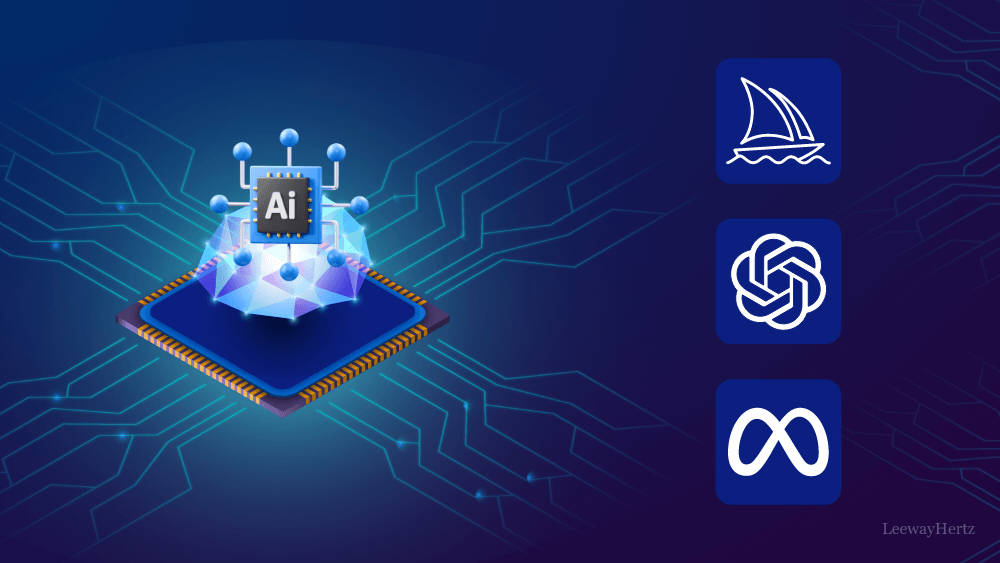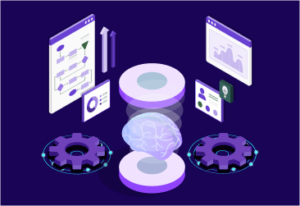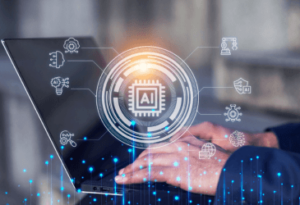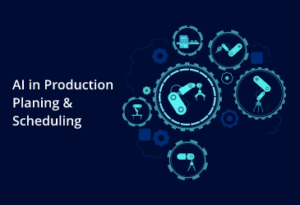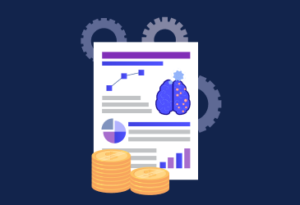AI use cases in the automotive industry
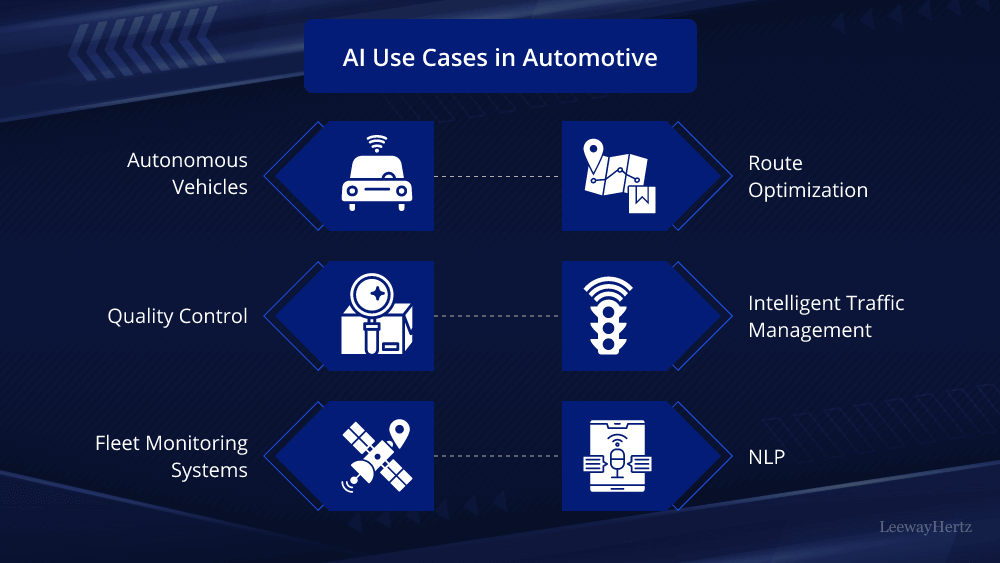
The automotive industry is one of the largest industries in the world and is a major contributor to global economic growth. Interestingly, the AI boom is making its way into the automotive industry, much like it has in a lot of other sectors. AI has enabled companies like Tesla, Volvo, BMW, and Volkswagen to improve the operational mechanics of their vehicles, making driving more convenient and efficient. As per Statista, the global automotive intelligence market is projected to reach a value of $74.5 billion by 2030, highlighting the growing significance of AI in the industry.
As we look ahead, the automotive workforce will need to adapt and become more tech-savvy to keep up with the changing landscape. By leveraging AI, the automotive sector can improve business operations, enhance quality control, and provide a better driving experience. From manufacturing and design to sales, marketing and service, AI has impacted almost all the sectors of the automotive industry. As a result, cars are becoming more intelligent, safer, and efficient.
As the industry shifts its focus from hardware to software, vehicle manufacturers need to adapt their workflows to fully embrace the benefits of AI in automotive innovation. This article provides a brief overview of AI in the automotive industry, delves into the benefits it offers, explores various use cases, highlights the driving AI technologies behind automotive innovation, and showcases leading automotive companies leveraging AI.
- AI in the automotive industry: An overview
- AI use cases in the automotive industry
- AI-powered advancements in automotive safety and autonomy
- Predictive maintenance
- Natural Language Processing (NLP) for infotainment
- Intelligent traffic management
- Enhanced navigation
- Personalized customer experience
- Route optimization
- Fleet monitoring systems
- Automotive insurance and risk assessment
- Connected vehicles
- AI in Automotive: Use cases across various departments
- How does AI enhance every step of the automotive manufacturing workflow?
- How to implement AI in the automotive industry?
- How LeewayHertz’s generative AI solution redefines operational excellence in automotive
- Benefits of AI in the automotive industry
- AI technologies driving automotive innovation
- Future prospects of AI in the automotive industry
AI in the automotive industry: An overview
AI in the automotive industry has redefined vehicle technology and driving experiences. Through advanced machine learning and data analytics, AI enables autonomous driving, enhancing safety and efficiency. Advanced features like lane departure warnings, adaptive cruise control, and parking assistance leverage AI algorithms. Natural language processing enables voice-activated infotainment systems, while predictive maintenance optimizes vehicle health. Moreover, AI enhances supply chain management and manufacturing processes, boosting efficiency. As AI continues to evolve, the automotive sector is poised to deliver even safer, more connected, and self-driving vehicles, reshaping the future of transportation.
AI use cases in the automotive industry
The automotive industry has been rapidly adopting AI to enhance safety, efficiency, and overall driving experience. Here are some detailed AI use cases in the automotive industry:
AI-powered advancements in automotive safety and autonomy
Autonomous Vehicles and ADAS are two interconnected pillars of automotive technology, both harnessing AI to enhance safety and driving experiences. Autonomous vehicles push the boundaries of AI by enabling vehicles to operate without human intervention. They rely on innovative sensor technology, including LiDAR for depth perception, radar for object detection, ultrasonic sensors for proximity awareness, and cameras for visual input. AI algorithms then analyze this comprehensive dataset to inform decisions regarding acceleration, braking, steering, and navigation. Machine learning, especially deep learning, plays a pivotal role in tasks such as object recognition, lane maintenance, and route planning. This progressive technology aims to redefine driving by minimizing human error, empowering vehicles to navigate intricate environments, and potentially paving the way for fully autonomous vehicles in the future.
On the other hand, Advanced Driver Assistance Systems (ADAS) harness AI to enhance vehicle safety and assist drivers. These systems integrate a suite of sensors, including cameras and radar, along with AI algorithms to continually assess the vehicle’s surroundings and offer real-time support. ADAS encompasses a variety of features, such as adaptive cruise control, automated emergency braking, lane departure warnings, blind-spot monitoring, and parking assistance. AI-driven computer vision algorithms process incoming data to recognize road signs, pedestrians, and other vehicles, enabling the system to promptly alert the driver or take corrective actions when necessary.
Predictive maintenance
Predictive maintenance harnesses AI to prevent vehicle breakdowns and optimize maintenance schedules. By analyzing data from sensors embedded within vehicles, AI algorithms identify patterns and anomalies that indicate potential component failures. This data-driven approach enables manufacturers, fleet operators, and service centers to anticipate maintenance needs before issues arise. By addressing problems proactively, predictive maintenance minimizes downtime, improves vehicle reliability, and reduces maintenance costs. This application underscores how AI enhances automotive operations by optimizing maintenance practices and ensuring vehicles remain in optimal working condition.
Natural Language Processing (NLP) for infotainment
NLP for infotainment utilizes AI to enable seamless communication between drivers and in-car systems. Through voice recognition and NLP technologies, drivers can interact with the vehicle’s infotainment system using natural language commands. This hands-free control enhances driving safety and convenience, allowing users to make calls, adjust navigation, play music, or control climate settings without taking their hands off the wheel. NLP algorithms process spoken language, understand intent, and execute commands, reshaping the driving experience and minimizing distractions.
Intelligent traffic management
Intelligent traffic management leverages AI to analyze real-time traffic data from sources like GPS and surveillance cameras. By processing this information, AI algorithms optimize traffic flow, reduce congestion, and enhance road safety. Adaptive traffic signal control systems adjust signal timings based on traffic conditions, easing bottlenecks. Dynamic route planning suggests alternate paths to drivers, minimizing travel time. Additionally, AI-powered accident detection systems swiftly identify incidents, enabling prompt response and rerouting.
Enhanced navigation
Enhanced navigation powered by AI brings advanced capabilities to traditional GPS systems. AI algorithms offer optimized routes that consider current circumstances by integrating real-time data from various sources, such as traffic information, road conditions, weather updates, and even driver behavior. These algorithms adapt routes dynamically to avoid congestion, accidents, and road closures, providing drivers with quicker and more efficient paths. Moreover, AI-driven navigation systems can incorporate points of interest, fuel and charging stations, catering to the driver’s preferences and needs. This application enhances driving experiences by reducing travel times, minimizing stress, and ensuring drivers reach their destinations using the most efficient and up-to-date routes.
Personalized customer experience
In the automotive industry, personalized customer experience involves using AI to tailor interactions and services to individual preferences and needs. AI algorithms can create personalized recommendations for vehicle features, maintenance schedules, and accessories by analyzing data such as past purchases, driving habits, and communication preferences. Delivering relevant information and offers enhances customer engagement, loyalty, and satisfaction. Furthermore, AI-driven chatbots provide instant assistance, answering queries and guiding customers through various processes like purchasing, scheduling maintenance, or troubleshooting issues.
Route optimization
Route optimization utilizes AI to find the most efficient and cost-effective routes for vehicles. By analyzing data such as traffic conditions, road closures, and delivery schedules, AI algorithms determine optimal paths that minimize travel time and fuel consumption. This is particularly crucial for commercial vehicles, like delivery trucks or service vehicles, to ensure timely deliveries and reduced operational costs. AI-driven route optimization enhances productivity, reduces emissions, and improves overall resource utilization, making it an essential tool for logistics and transportation management.
Fleet monitoring systems
Fleet monitoring systems utilize AI to manage and optimize a group of vehicles, often used for commercial purposes. These systems gather data from vehicles’ onboard sensors, GPS devices, and other sources to provide real-time insights into vehicle performance, location, and driver behavior. AI algorithms process this data to offer fleet managers a comprehensive view of their operations, including route optimization, fuel efficiency, maintenance scheduling, and driver performance. By analyzing patterns and trends, fleet monitoring systems help improve operational efficiency, reduce costs, enhance safety, and ensure compliance with regulations.
Automotive insurance and risk assessment
AI is used for insurance and risk assessment to determine insurance premiums and evaluate potential risks associated with vehicles and drivers. Telematics devices collect data on driving behavior, including speed, braking patterns, acceleration, and more. AI algorithms analyze this data to create accurate driver profiles, assessing individual risk levels. Insurers can offer personalized insurance rates based on driving habits, rewarding safer drivers with lower premiums and encouraging responsible behavior on the road. This AI application in automotive enhances the fairness and accuracy of insurance pricing while promoting safer driving practices. Additionally, AI can predict accident probabilities based on historical data and real-time conditions, allowing insurance companies to make more informed decisions about coverage and risk mitigation strategies.
Connected vehicles
Connected vehicles utilize AI and communication technologies to exchange real-time data with other vehicles, infrastructure, and external systems. Equipped with sensors and communication modules, these vehicles enable AI algorithms to enhance traffic management, collision avoidance, predictive maintenance, and navigation. They communicate with each other (V2V) and with infrastructure (V2I), enabling cooperative collision avoidance and data-driven road safety improvements. The data collected and analyzed by AI in connected vehicles contributes to creating a safer, more efficient driving environment and serves as a foundational step toward advanced autonomous driving systems.
These are some of the significant AI applications in the automotive industry that enable autonomous driving, enhance safety features, optimize manufacturing and supply chain processes, improve customer experiences, and redefine how vehicles are designed, produced, and used.
AI in Automotive: Use cases across various departments
Research and Development (R&D)
One prominent use case within R&D in the automotive industry involves the application of AI for vehicle design optimization. AI-driven simulations and predictive modeling can analyze numerous design configurations, ranging from aerodynamics and structural integrity to safety features. By leveraging machine learning algorithms, R&D teams can predict and evaluate the performance of different design elements, reducing the reliance on physical prototypes and significantly expediting the design process. This use of AI not only accelerates innovation but also contributes to the development of more fuel-efficient, safer, and technologically advanced vehicles, ultimately enhancing the competitiveness and sustainability of automotive companies in an ever-evolving market.
Manufacturing
Manufacturing optimization employs AI to streamline production processes in the automotive industry. AI algorithms analyze data from various stages of manufacturing, identifying bottlenecks, predicting equipment failures, and optimizing assembly line operations. This data-driven approach enhances efficiency, reduces costs, and elevates product quality. Manufacturing optimization maximizes productivity while minimizing waste by ensuring smooth operations and detecting defects early. This AI application plays a crucial role in meeting production demands and maintaining high standards in the automotive manufacturing process.
Sales and Marketing
In the automotive industry’s sales and marketing domain, AI-driven personalization is a pivotal use case. AI algorithms analyze a vast array of customer data, including preferences, purchase history, and online behaviors, in order to develop highly targeted and personalized marketing campaigns. By delivering precisely tailored advertisements and promotions to individual customers, automotive companies can significantly boost their marketing effectiveness. This not only leads to increased customer engagement but also enhances the likelihood of attracting potential buyers. Ultimately, AI-powered personalization redefines the sales and marketing approach in the automotive sector by aligning promotional efforts more closely with each customer’s unique needs and interests, thereby driving sales and brand loyalty.
Finance and Accounting
Within the finance and accounting departments of the automotive industry, AI is instrumental in automating expense management processes. AI-driven expense management systems can analyze and categorize expense reports, eliminating the need for extensive manual work. Moreover, these systems can employ machine learning to detect potentially fraudulent expenses, enhancing financial control and compliance. By automating these routine tasks, AI not only reduces human error but also allows finance professionals to focus on more strategic financial planning and analysis, ultimately improving the overall financial health and efficiency of automotive companies while ensuring greater financial transparency and security.
Human Resources (HR)
In the HR department of the automotive industry, AI-powered recruitment emerges as one of the most important use cases. AI algorithms can meticulously analyze job applications, resumes and candidate data to determine the most qualified candidates for various automotive industry positions. These systems can also automate initial candidate screening, rapidly sifting through large volumes of applications and resumes to shortlist top candidates. By streamlining the recruitment process, AI expedites hiring and ensures a more precise match between candidates and job requirements, resulting in higher-quality hires. This use of AI in HR not only saves time and resources but also enhances the talent acquisition process, contributing to the overall competitiveness and success of automotive companies in the talent-driven market.
Packaging and dispatch department
AI is redefining logistics with advanced route optimization and real-time decision-making. AI algorithms analyze a multitude of factors, including delivery destinations, traffic conditions, vehicle capacities, and time constraints, to plan and adjust delivery routes dynamically. This ensures efficient and timely dispatch of vehicles and parts while minimizing transportation costs and reducing environmental impact. By harnessing the power of AI, automotive companies streamline their packaging and dispatch operations, enhancing customer satisfaction through punctual deliveries, achieving cost savings, and contributing to sustainability objectives in a rapidly evolving automotive landscape.
Legal and compliance
AI-powered contract analysis plays a pivotal role within the legal and compliance departments of the automotive industry. AI algorithms can meticulously review and analyze contracts, extracting key terms, clauses, and obligations, ensuring that the company strictly adheres to relevant laws and regulations. Additionally, machine learning can assist in identifying potential legal risks and compliance issues within complex legal documents. This use of AI not only expedites contract analysis but also minimizes the risk of human oversight, improving legal accuracy and ensuring that the automotive company operates within legal boundaries. It boosts the overall efficiency and effectiveness of the legal and compliance functions, reducing the potential for legal disputes and associated costs.
Information Technology (IT)
One critical use case in the IT domain of the automotive industry involves cybersecurity threat detection and prevention. AI-driven cybersecurity systems continuously monitor network traffic, analyze patterns, and identify anomalies that could suggest potential cyber threats or attacks. By leveraging ML algorithms, these systems can identify and respond to threats in real-time, enhancing the security of sensitive automotive data, manufacturing processes, and connected vehicle systems. This proactive approach safeguards against cyberattacks and ensures the integrity and reliability of automotive technologies, ultimately fostering trust among consumers and partners in an increasingly digital and interconnected automotive landscape.
These AI use cases demonstrate how artificial intelligence can be applied across various departments within the automotive industry to improve efficiency, reduce costs, enhance customer experiences, and drive innovation.
How does AI enhance every step of the automotive manufacturing workflow?
The automotive manufacturing process is a complex and multi-stage operation that involves various steps from design to production. Here are the typical stages/phases in the automotive manufacturing process:
Concept and design
Traditional process: Engineers and designers create initial concepts and designs based on market demands and regulatory requirements.
AI application: AI can assist in design optimization, generative design, and simulation to improve the efficiency and performance of vehicle components. ML algorithms play a pivotal role in examining market trends and understanding customer preferences, offering valuable insights that guide and influence design decisions.
Engineering and prototyping
Traditional process: Detailed engineering is performed to refine the design, and prototypes are built for testing and validation.
AI application: AI-driven simulations and virtual prototyping can help in accelerated testing and validation, reducing the time and cost associated with physical prototypes. This includes simulations for crash testing, aerodynamics, and thermal analysis.
Tooling and manufacturing planning
Traditional process: Tools and manufacturing processes are planned based on the finalized design.
AI application: AI can optimize tooling processes, predict maintenance needs for machinery, and assist in scheduling and resource planning to enhance overall manufacturing efficiency.
Stamping and body assembly
Traditional process: Metal sheets are stamped into components, and body parts are assembled.
AI application: Computer vision systems powered by AI can improve quality control by detecting defects in stamped parts. AI can also optimize robot movements in the assembly process to increase speed and precision.
Painting
Traditional process: The vehicle body is painted to provide protection and aesthetics.
AI application: AI can optimize paint application processes, ensuring uniformity and reducing defects. Utilizing computer vision for quality control during the painting stage is another application that enhances overall quality assurance.
Assembly
Traditional process: Vehicle components are assembled on the production line.
AI application: AI-driven robotics can improve automation in assembly lines, increasing efficiency and reducing errors. Computer vision systems can be used for quality checks during assembly.
Testing and quality control
Traditional process: Vehicles undergo rigorous testing for performance, safety, and quality.
AI application: AI can enhance testing processes through predictive maintenance of testing equipment, real-time monitoring, and analysis of test data. Machine learning algorithms excel at recognizing patterns and detecting anomalies, contributing to the assurance of product quality.
Supply chain management
Traditional process: Managing the supply chain for raw materials and components.
AI application: AI can optimize supply chain operations by predicting demand, identifying potential disruptions, and improving inventory management through predictive analytics.
Sales and after-sales service
Traditional process: Vehicles are marketed and sold, and after-sales services are provided.
AI application: AI can assist in customer relationship management, personalized marketing, predictive maintenance for vehicles in the field, and enhancing the overall customer experience.
AI plays a crucial role in addressing challenges throughout the automotive manufacturing process by improving efficiency, reducing costs, enhancing quality control, and enabling predictive maintenance. The application of AI technologies in each stage contributes to the overall optimization of the automotive manufacturing industry.
How to implement AI in the automotive industry?
Implementing artificial intelligence (AI) in the automotive industry can lead to significant enhancements in efficiency, safety, and overall performance. Here’s a guide on how to implement AI in the automotive business:
Define objectives and goals: Define your AI implementation goals and objectives with precision and clarity. This could include improving vehicle safety, enhancing manufacturing processes, optimizing supply chain management, or developing autonomous vehicles.
Data collection and integration: Gather and integrate diverse datasets from various sources, including sensors, IoT devices, and historical data. Quality and diversity of data are crucial for training robust AI models.
Develop AI models: Employ machine learning algorithms to develop AI models tailored to your specific objectives. Common applications in the automotive industry include predictive maintenance, defect detection, quality control, and demand forecasting.
Autonomous vehicles: If focusing on autonomous driving, develop advanced algorithms for perception, decision-making, and control. Consider partnerships or collaborations with specialized companies in the autonomous vehicle space.
Human-Machine Interface (HMI): Implement AI-driven HMI solutions for improved user experience. Gesture control, voice recognition, and natural language processing can enhance the interaction between drivers and vehicles.
Supply chain optimization: Utilize AI for supply chain management to optimize inventory, demand forecasting, and logistics. Predictive analytics can help streamline the production process and reduce costs.
Predictive maintenance: Implement AI-based predictive maintenance systems to monitor vehicle health and predict potential failures. This can reduce downtime, extend the lifespan of vehicles, and improve overall reliability.
Cybersecurity: Integrate AI for cybersecurity measures to protect connected vehicles from potential threats. AI has the capability to identify and promptly respond to anomalies in real-time, ensuring the safety and security of both the vehicle and its occupants.
Collaborate and partner: Collaborate with AI technology providers, startups, and research institutions. Partnering with experts can accelerate the development and deployment of AI solutions and bring diverse perspectives to the table.
Regulatory compliance: Stay abreast of and comply with relevant regulations in the automotive industry, especially those related to autonomous driving and data privacy. Engage with regulatory bodies to ensure your AI implementations align with legal requirements.
Continuous improvement: Establish a feedback loop to facilitate ongoing enhancements and continuous improvement. Regularly update AI models based on real-world performance and user feedback. This iterative process ensures that your AI solutions remain effective and relevant over time.
Employee training and change management: Provide training programs for employees to adapt to AI technologies. Address any concerns about job displacement by emphasizing the collaborative nature of AI-human partnerships.
Ethical considerations: Consider ethical implications in AI development, particularly in autonomous driving. Develop guidelines for ethical decision-making by AI systems and ensure transparency in how data is used.
Testing and validation: Rigorously test and validate AI models under various conditions to ensure their reliability and safety. Use simulations, real-world testing, and validation against industry standards.
Scale gradually: Implement AI solutions gradually, starting with pilot projects and scaling up based on success and feedback. This approach allows for refinement and adjustment as needed.
If you’re in the automotive business and need a reliable tech partner, turn to LeewayHertz. They specialize in generative AI consulting and development services, ready to take your automotive enterprise into the digital era. With a successful history of implementing various advanced LLM models and solutions, LeewayHertz is here to support and advance your journey into the world of AI.
How LeewayHertz’s generative AI solution redefines operational excellence in automotive
LeewayHertz’s generative AI platform, ZBrain, plays a transformative role in optimizing workflows across diverse industries. As a comprehensive, enterprise-ready platform, ZBrain empowers businesses to design and implement applications tailored to their specific operational requirements. The platform uses clients’ data, whether in the form of text, images, or documents, to train advanced LLMs like GPT-4, Vicuna, Llama 2, or GPT-NeoX for developing contextually aware applications capable of performing diverse tasks. The resulting applications contribute to informed decision-making, provide in-depth insights into vehicle performance and manufacturing processes, and enhance overall productivity, all while adhering to stringent data privacy standards.
Challenges such as intricate supply chain management, dynamic sales forecasting, and stringent quality control standards are prevalent in the automotive sector. ZBrain effectively addresses these challenges through its distinctive feature called “Flow,” which provides an intuitive interface that allows users to create intricate business logic for their apps without the need for coding. Flow’s easy-to-use drag-and-drop interface enables the seamless integration of prompt templates, large language models, and other generative AI models into your app’s logic for its easy conceptualization, creation, or modification.
By leveraging ZBrain apps, enterprises can achieve heightened efficiency, minimized error rates, and an overall improvement in product quality, gaining comprehensive solutions to some of the most pressing challenges in the automotive sector. Here is how ZBrain can benefit your automotive business:
AI-driven quality control and defect analysis
ZBrain adeptly addresses the challenge of quality control in the automotive industry. Utilizing LLM-based applications developed with ZBrain, businesses can streamline the process of identifying and analyzing vehicle defects. This leads to enhanced accuracy in quality assessments and a significant reduction in time and resources typically required for manual inspections. The benefits for automotive businesses include improved product quality, increased operational efficiency, and higher customer satisfaction. To see how ZBrain transforms automotive quality control and ensures superior vehicle standards, you can explore the specific process Flow here.
AI-driven sales forecasting and market analysis
ZBrain simplifies the complex task of sales forecasting and market analysis, empowering automotive businesses to make informed decisions with tailored solutions. Through LLM-based apps created using ZBrain, businesses can automate traditionally manual tasks, allowing teams to focus on critical business aspects. To understand how ZBrain transforms sales forecasting and market analysis in the automotive sector, delve into this detailed Flow.
AI-driven supply chain optimization
ZBrain addresses the challenge of achieving optimal efficiency in the supply chain, redefining automotive supply chain management by automating processes and transforming the management of supply chains into a swift and efficient operation. Through LLM-based apps created using ZBrain, automotive companies can gain comprehensive insights for data-driven decision-making that not only saves time and resources but also reinforces operational efficiency. To know how ZBrain transforms supply chain management, dive into this detailed Flow for a comprehensive overview.
Benefits of AI in the automotive industry
AI has brought about significant shifts in the automotive industry, offering numerous benefits across various aspects. Here are some of the key benefits of AI in the automotive industry:
- Enhanced safety: AI-powered driver assistance systems, such as lane departure warnings, automatic emergency braking, and adaptive cruise control, help prevent accidents and reduce human errors on the road.
- Improved efficiency: AI algorithms optimize fuel consumption, route planning, and traffic management, leading to more efficient transportation, reduced congestion, and lower environmental impact.
- Predictive maintenance: AI analyzes vehicle data and sensor inputs to detect maintenance issues proactively. This helps prevent breakdowns, optimize maintenance schedules, and reduce downtime, resulting in cost savings for both manufacturers and consumers.
- Personalized user experience: AI enables voice recognition, natural language processing, and gesture control, enhancing the in-car user experience. Drivers can interact with infotainment systems, navigation, and climate control through intuitive interfaces.
- Quality control and manufacturing optimization: AI algorithms can detect defects, anomalies, and quality issues during production, improving manufacturing efficiency and reducing wastage.
- Data-driven insights: AI can analyze vast amounts of vehicle and customer data, providing valuable insights into user preferences, driving patterns, and market trends. This data-driven approach helps automakers make informed decisions regarding product development, marketing strategies, and customer satisfaction.
- Supply chain optimization: AI optimizes inventory management, demand forecasting, and supplier selection, streamlining the supply chain, reducing costs, and improving overall efficiency.
- Infrastructure planning: AI can analyze data to aid urban planning, helping design roads, traffic flow, and charging infrastructure for electric vehicles.
- Connected vehicles: AI enables vehicles to communicate with each other and with infrastructure (V2V and V2X communication). This can enhance safety by providing real-time information about road conditions, traffic, and potential hazards.
- Insurance and telematics: AI-powered telematics systems can track driving behavior and provide data for usage-based insurance. This encourages safer driving habits and personalized insurance premiums.
- Cost savings: AI technologies in the automotive industry lead to cost savings by optimizing manufacturing processes, reducing maintenance expenses, and enhancing supply chain efficiency.
AI technologies driving automotive innovation
Integrating AI in automotive has brought about a seismic shift in the industry. Various AI technologies are propelling innovation and redefining vehicles from mere modes of transportation into intelligent, connected, and autonomous machines. Here, we will delve into the key AI technologies driving automotive innovation and redefining how we perceive vehicles.
Computer vision: Enabling perception
At the core of many AI-powered automotive advancements lies computer vision, a technology that enables machines to interpret and understand their surroundings using visual information. Equipped with cameras and using image processing algorithms, vehicles can identify objects, pedestrians, lane markings, and traffic signs. Some common image recognition and computer vision algorithms include convolutional neural networks (CNNs), which are used for tasks like object detection, lane detection, and pedestrian recognition. YOLO (You Only Look Once) is a real-time object detection algorithm that can be used for detecting and classifying objects in images and video streams. Semantic segmentation algorithms label each pixel in an image with its corresponding object class, aiding in tasks like scene understanding and autonomous driving. Computer vision is pivotal in advanced driver assistance systems (ADAS), enabling features like lane departure warnings, adaptive cruise control, and automatic emergency braking. Moreover, it is a cornerstone of autonomous driving, allowing vehicles to navigate complex environments by making real-time decisions based on camera data.
Sensor fusion: Comprehensive perception
In the pursuit of creating safer and more efficient vehicles, AI technologies such as sensor fusion are being employed to create a more holistic perception of the environment. Vehicles can build a multidimensional understanding of their surroundings by integrating data from various sensors such as radar, LiDAR, ultrasonic sensors, and cameras. Sensor fusion provides redundancy and accuracy, crucial for ensuring reliable performance in challenging conditions and scenarios.
Natural Language Processing (NLP): Human-vehicle interaction
The evolution of vehicles goes beyond driving mechanics; it encompasses the interaction between humans and machines. NLP is at the core of creating seamless communication between drivers and their vehicles. Voice recognition systems powered by NLP allow drivers to control infotainment systems, navigation, and climate settings using natural language commands. This technology enhances user experience, making the driving environment more intuitive and less distracting.
Reinforcement learning: Autonomous decision-making
Reinforcement learning, a subset of ML, has proven instrumental in training autonomous vehicles to make complex decisions in real-time scenarios. Through trial and error, these vehicles learn how to navigate roads, avoid obstacles, and react to dynamic traffic conditions. Reinforcement learning enables autonomous vehicles to adapt and improve their driving behaviors over time, ultimately enhancing safety and efficiency.
Neural networks and deep learning: Pattern recognition
Neural networks, particularly deep learning models like convolutional neural networks (CNNs), have redefined pattern recognition tasks within the automotive sector. These networks excel at object detection, image classification, and semantic segmentation tasks. In the automotive context, CNNs enable vehicles to detect pedestrians, other vehicles, and road signs, contributing to both ADAS and autonomous driving capabilities.
The convergence of AI technologies is redefining the automotive landscape. Computer vision, sensor fusion, natural language processing, reinforcement learning, and deep learning collectively redefine vehicles into intelligent entities capable of perception, interaction, and decision-making. As these technologies advance, we can expect vehicles to become not just modes of transportation but sophisticated companions that enhance safety, convenience, and overall driving experience.
Future prospects of AI in the automotive industry
The future of AI in the automotive industry holds promising trends that are set to reshape various aspects of the sector. As businesses continue to navigate challenges, they are also capitalizing on emerging opportunities to shape the future of transportation. Here are the key trends that are expected to drive innovation and growth:
- Enhanced data privacy and security solutions: Future AI systems in vehicles will prioritize robust data privacy and security mechanisms. Advanced encryption techniques, decentralized data storage, and secure communication protocols will be implemented to protect sensitive information. Manufacturers will work closely with regulatory frameworks and standards to ensure ethical data handling practices, ultimately building trust among consumers.
- Skill development and workforce evolution: The increasing integration of AI in the automotive landscape will propel the need for a skilled workforce. Industry professionals will be encouraged to upskill and specialize in areas such as AI-driven vehicle systems, cybersecurity, and AI ethics.
- Seamless edge computing and real-time processing: The future will witness advancements in edge computing capabilities within vehicles and roadside infrastructure. AI algorithms will become more efficient, enabling real-time processing of data even with limited computational resources. Innovations in bandwidth optimization and edge AI architecture will overcome existing challenges and offer smoother data transmission.
- Integration with smart city ecosystems: AI-powered vehicles will seamlessly integrate with smart city infrastructure, fostering an ecosystem of interconnected transportation solutions. Vehicles will communicate with traffic management systems, parking facilities, and public transportation networks to optimize traffic flow, reduce congestion, and enhance overall urban mobility.
- Autonomous driving dominance: The shift towards autonomous vehicles will gather momentum, with AI at the core of their operation. Enhanced sensor technologies, deep learning algorithms, and real-time decision-making capabilities will drive the transition from manual to autonomous driving. Consumers will increasingly adopt self-driving features for their convenience and safety.
- Human-machine interaction advancements: Natural language processing (NLP) and computer vision will advance the way humans interact with vehicles. AI-powered voice assistants and gesture recognition systems will enhance the in-cabin experience, making it more intuitive and user-friendly.
- Eco-friendly driving solutions: AI algorithms will significantly optimize vehicle efficiency and reduce carbon emissions. Smart energy management systems will adapt driving behavior based on real-time traffic conditions and environmental factors, contributing to sustainable transportation solutions.
The future trends of AI in the automotive industry are poised to redefine how we perceive transportation. As AI becomes an integral part of vehicle technology, it will continue to drive advancements, making the journey from concept to reality an exciting and innovative one.
Conclusion
The automotive industry is experiencing a significant shift with the integration of AI into various aspects of its operations. The adoption of AI technologies has opened up a world of possibilities and opportunities for automakers and consumers alike. From advanced driver assistance systems to personalized services and predictive maintenance, AI is redefining the automotive landscape, offering unparalleled opportunities for innovation, safety, efficiency, and personalized experiences. The future of the automotive industry is undoubtedly intertwined with the limitless potential of AI, and its impact will continue to reshape the way we drive, travel, and interact with vehicles.
Unlock the potential for efficiency, safety, and growth in your automotive business by utilizing robust AI-powered solutions. Contact LeewayHertz’s developers now for AI consultancy and development services for your business.
Start a conversation by filling the form
All information will be kept confidential.
FAQs
What is the role of AI in the automotive industry?
AI in the automotive industry plays a pivotal role in enhancing autonomous driving, predictive maintenance, personalized user experiences and more. Machine learning algorithms process substantial amounts of data to improve vehicle safety, efficiency, and overall performance.
How is User Experience (UX) integrated into automotive design using AI?
AI plays a crucial role in enhancing UX in automotive design. It is utilized for features like personalized driver profiles, voice-controlled infotainment systems, predictive maintenance alerts, and intelligent driver assistance systems. By analyzing user preferences and behavior, AI tailors the in-car experience, making it more intuitive, convenient, and enjoyable.
What is the role of artificial intelligence in automotive engineering?
In automotive engineering, AI is employed for various purposes. AI plays a pivotal role in advancing autonomous vehicles by facilitating the enhancement of perception, decision-making, and control systems. It is used in predictive maintenance to anticipate potential issues and optimize vehicle performance. Additionally, AI enhances safety through features like collision avoidance and assists in the design process by facilitating generative design and simulations for improved efficiency and innovation.
What challenges does AI address in the automotive sector?
AI addresses challenges in the automotive sector, such as road safety, traffic management, and environmental impact. Through autonomous driving capabilities and data-driven insights, AI contributes to creating safer and more sustainable transportation solutions.
Does LeewayHertz address cybersecurity concerns related to AI-enabled automotive systems?
Certainly, LeewayHertz prioritizes cybersecurity in AI-enabled automotive systems. We employ stringent measures to safeguard AI-driven automotive technologies, protecting vehicles from potential cyber threats and ensuring their safety and security.
How does LeewayHertz ensure data privacy in AI-driven automotive applications?
LeewayHertz prioritizes data privacy in AI-driven automotive applications by implementing robust encryption, access controls, and adherence to industry-standard data protection regulations. Our measures are designed to safeguard sensitive information and ensure compliance with privacy standards.




